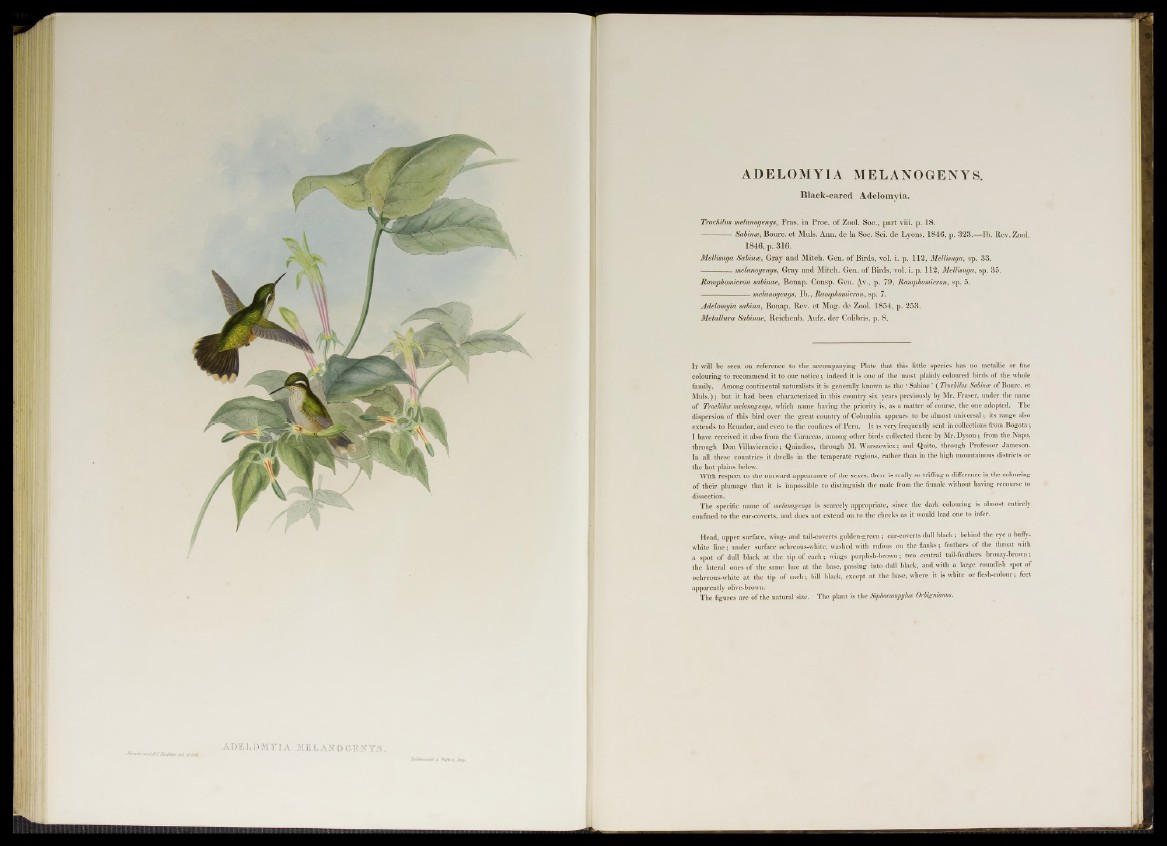
ADELOMYIA MELANOGENYS.
Black-eared Adelomyia.
Trochilus melanogenys, Fras. in Proc. o f Zool. Soc., part viii. p. 18.
-------------Sabina?, Bourc. et Muls. Ann. de la Soc. Sci. de Lyons, 1846, p. 323.—Ib. Rev. Zool.
1846, p. 316.
Mellisuga Sabinoe, Gray and Mitch. Gen. o f Birds, vol. i. p. 112, Mellisuga, sp. 33.
------------- melanogenys, Gray and Mitch. Gen. o f Birds, vol. i. p. 112, Mellisuga, sp. 35.
Ramphomicron sabinae, Bonap. Consp. Gen. Av., p. 79, Ramphomicron, sp. 5.
--------------------- melanogenys, Ib., Ramphomicron, sp. 7.
Adelomyia sabina, Bonap. Rev. et Mag. de Zool. 1854, p. 253.
Metallura Sabinae, Reichenb. Aufz. der Colibris, p. 8.
It will be seen on reference to the accompanying Plate that this little species has no metallic or fine
colouring to recommend it to our notice; indeed it is one of the most plainly coloured birds of the whole
family. Among continental naturalists it is generally known as the ‘ Sabine ’ ( Trochilus Sabince of Bourc. et
Muls.); but it had been characterized in this country six years previously by Mr. Fraser, under the name
of Trochilus melanogenys, which name having the priority is, as a matter of course, the one adopted. The
dispersion of this bird over the great country of Columbia appears to be almost universal; its range also
extends to Ecuador, and even to the confines of Peru. It is very frequently sent in collections from Bogota;
I have received it also from the Caraccas, among other birds collected there by Mr. Dyson; from the Napo,
through Don Villavicencio; Quindios, through M. Warszewicz; and Quito, through Professor Jameson.
In all these countries it dwells in the temperate regions, rather than in the high mountainous districts or
the hot plains below.
With respect to the outward appearance of the sexes, there is really so trifling a difference in the colouring
of their plumage that it is impossible to distinguish the male from the female without having recourse to
dissection.
The specific name of melanogenys is scarcely appropriate, since the dark colouring is almost entirely
confined to the ear-coverts, and does not extend on to the cheeks as it would lead one to infer.
Head, upper surface, wing- and tail-coverts golden-green; ear-coverts dull black; behind the eye a buffy-
white line; under surface ochreous-white, washed with rufous on the flanks; feathers of the throat with
a spot of dull black at the tip of each; wings purplish-brown; two central tail-feathers bronzy-brown;
the lateral ones of the same hue at the base, passing into dull black, and with a large roundish spot of
ochreous-white at the tip of each; bill black, except at the base, where it is white or flesh-colour; feet
apparently olive-brown.
The figures are of the natural size. The plant is the Siphocampylus Orhigmanm.